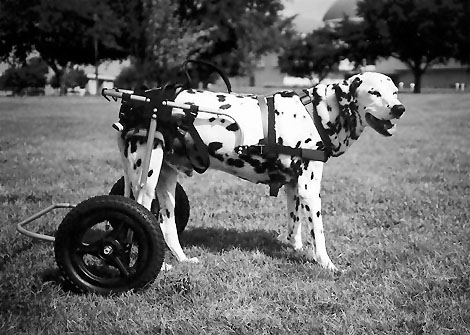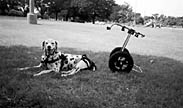Wheels - by John Sealander

|
If hope can come in a box, this was it. I had ordered the wheelchair almost a month ago, but since it had to be custom fitted to Spot's size and weight, I spent each passing day hoping that he wouldn't be too weak to use the wheelchair by the time it actually arrived. The day the big UPS box arrived at the front door, I wasn't sure that Spot would be able to use his new wheels at all. All I could do was look at the box and hope. Inside was perhaps the one chance I had left that Spot would walk again. Spot couldn't get up or down anymore, but he learned to bark whenever he needed help and I would come lift him up to make our slow walks to the water bowl in the kitchen or a tree he wanted to pee under in the back yard. At first he didn't like wearing the Walkabout harness at all. When he discovered how much easier it was to get where he needed to go when he wore the harness full time, he adapted again. Pretty soon, he was even sleeping in the harness. When we needed to make our increasingly frequent 3AM bathroom trips to the backyard, we didn't have to sleepily fumble around trying to attach the complex contraption to his legs. I just grabbed the handles, lifted him up and off we went. If you've got a dog with spinal injuries or hip displacia, I can't say enough good things about the WalkAbout harness. It is sturdy, well designed and does a great job of giving an injured or crippled dog a basic level of mobility and dignity. Spot is a Dalmatian however, and as any Dalmatian owner will tell you, Dalmatians are never ready to settle for a basic level of anything. As Spot's condition continued to slowly deteriorate, I kept wondering if there was some way to give him the freedom and mobility he really wanted. I'd seen ads for wheelchairs in the back of dog magazines for years, but hadn't really thought much about them. My vet wasn't very encouraging either. She said that most wheelchairs weren't a very good long-term solution for large dogs, because it was easy to them to tip them over and hurt themselves if you weren't constantly watching them. She also said that canine wheelchairs didn't work in the house anyway because most dogs were continually getting the wheels stuck between furniture. I wasn't really looking for a long-term solution though. All I wanted was the ability to take Spot for a short walk in the park again. It would be nice if, at least for a little while, Spot could walk where he pleased, without the need for me to be to be marching in lockstep right behind him, holding the nylon Walkabout handles attached to his rear legs. I started researching wheelchairs for dogs and decided that a guy named Dewey Springer in Bend, Oregon made the best ones. We measured Spot from tip to toe and ordered his chair. Then we waited. By this point, Spot was taking Prednisone daily to help reduce the inflammation caused by the spondylosis. This, of course, made him drink water like there was no tomorrow. We were constantly making trips to the water bowl with the Walkabout harness and immediately afterwards, making another trip outside to pee. In and out we would go, often three or four times a night. We completely wore out one Walkabout and had to order another one to replace it. Spot's front legs were starting to get weaker too. We began putting two foot wide strips of carpet runner all over the house to give him more traction and stability on his regular routes from one room to another. On the smooth brick floors that covered most of the house, Spot was having increasing difficulty even standing upright. I had to get a harness for the front too, so I could keep his front legs from slowly sliding out from under him as he was drinking from his water bowl. The one ray of hope was that he still did pretty well outdoors. There was a dramatic difference in Spot's indoor and outdoor mobility. He still needed the Walkabout for mobility inside and out, but when he was walking on grass or dirt, his legs didn't slip and slide nearly as much and his rear legs seemed to move more or less normally. Dewey Springer, the wheelchair designer, had already told me that strong, younger dogs did a lot better using his chairs than older sick ones like Spot. Nevertheless, we both decided it was worth a try anyway. Spot lay beside me on the living room floor while I assembled the wheelchair components. The chair was remarkably light, strong and well balanced. It was designed to take weight off the dog's rear legs while still allowing them to touch the ground and move normally. There was a nylon and neoprene harness that was designed so that the dog could wear it permanently, allowing him to be quickly attached to the aluminum wheeled frame using quick release buckles. Luckily, Spot was so used to the Walkabout harness by the time it came to attach and adjust the harness for his wheelchair that he hardly seemed to notice. When the moment of truth came and I strapped Spot into the chair for the first time, all it took was a few minutes and a few of his favorite treats to teach him how to use it. He began to move forward slowly and tentatively at first, and then in true Dalmatian fashion, promptly pulled his fancy new transportation into a patch of high weeds and got it stuck. It may be a while before Spot gets his driver's license. He is constantly getting his new wheelchair stuck in brush or high grass and still doesn't appear to realize that he can't make hairpin turns around small trees. He also has a tendency to walk with one wheel up on the curb when traveling on neighborhood streets. He also likes to walk downhill a lot more than walking uphill, so I am occasionally left at the bottom of a hill with a tired 65 pound dog and an aluminum wheelchair contraption, wondering how we are going to get home again. Even though Spot tires easily using the wheelchair and is a hopelessly reckless driver, I'm glad we took a chance on this strange looking device. For the first time in months, Spot looks happy again. We move slowly and we don't go far, but from a dog's point of view, its back to normal again. He can smell the air, keep tabs on all the other dogs in "his" park and mark his favorite trees. Maybe that's enough. I don't expect miracles anymore. In truth,
the miracle has already happened. Spot is still alive and in good spirits
almost two years after his doctors said he had two weeks to live. No
Dalmatian lives forever, but if you can manage to give them a sense
of dignity and a little independence in their declining years, they
just might live a lot longer than you think.
If you enjoy these stories and would like to help this wonderful breed of dogs, please consider making a donation to Dalmatian Rescue of North Texas. Your donation will help Dalmatian Rescue continue to rescue and rehabilitate the hundreds of Dalmatians that are abandoned in North Texas every year. To help give a deserving Dalmatian a second chance, just click on the button to your left. You can use any major credit card to make your donation instantly and no matter what you choose to give, you can feel a little better knowing that you have helped a dog very much like Spot find the one thing it really needs: a home. |
copyrightę2001. Contact John Sealander at: john@sealander.com readers since6/13/01
 For
several months Spot's condition had been slowly deteriorating. The cumulative
effects of intestinal cancer, nerve damage from spondylosis and severe
arthritis were making it harder and harder for him to use his rear legs.
If Spot wasn't so resilient and adaptable, I might have admitted that
he was becoming paralyzed a bit sooner. Spot was a trooper though. As
his mobility decreased from month-to-month, his determination to continue
living the life of an active, curious Dalmatian actually seemed to increase.
He just wouldn't give up. At first, the changes in his lifestyle were
simple. He went from running free in the park on walks to always being
on a leash. As he became slower and less stable, the leash became shorter
and shorter. Finally the risk of a serious fall was too great with even
the shortest of leashes. The next step was a special
For
several months Spot's condition had been slowly deteriorating. The cumulative
effects of intestinal cancer, nerve damage from spondylosis and severe
arthritis were making it harder and harder for him to use his rear legs.
If Spot wasn't so resilient and adaptable, I might have admitted that
he was becoming paralyzed a bit sooner. Spot was a trooper though. As
his mobility decreased from month-to-month, his determination to continue
living the life of an active, curious Dalmatian actually seemed to increase.
He just wouldn't give up. At first, the changes in his lifestyle were
simple. He went from running free in the park on walks to always being
on a leash. As he became slower and less stable, the leash became shorter
and shorter. Finally the risk of a serious fall was too great with even
the shortest of leashes. The next step was a special